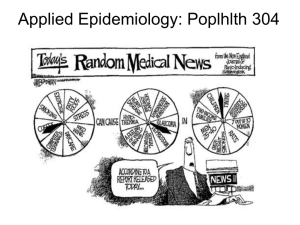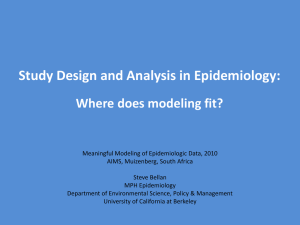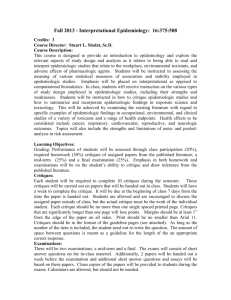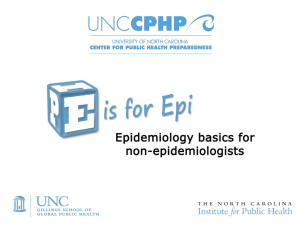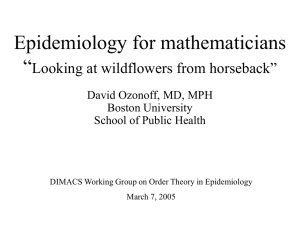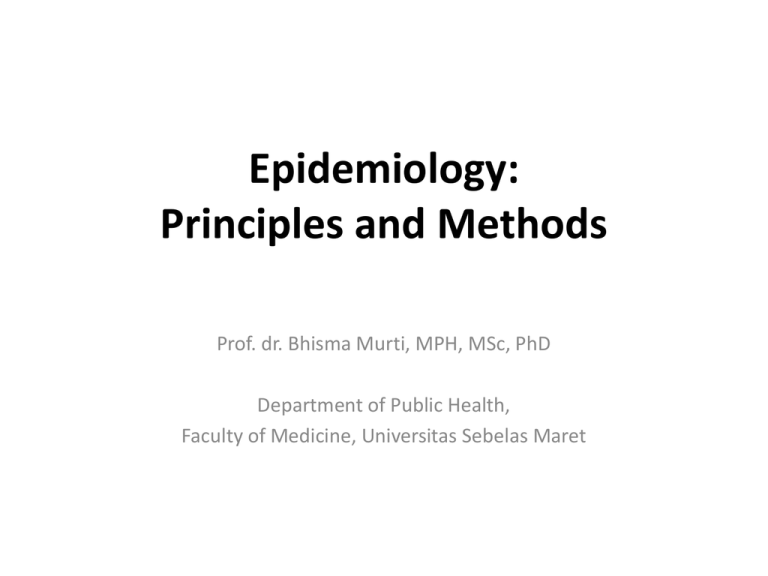
Epidemiology:
Principles and Methods
Prof. dr. Bhisma Murti, MPH, MSc, PhD
Department of Public Health,
Faculty of Medicine, Universitas Sebelas Maret
Definitions in Epidemiology
1.
2.
3.
Definition and aims of epidemiology
Study designs used in epidemiology
Measures of Disease Frequency
– Incidence (Cumulative Incidence and Incidence Density)
– Prevalence
4.
5.
6.
7.
8.
Measures of Association
Bias
Confounding
Chance
Causal Inference
Epidemiology
• A study of the distribution of disease frequency in human
population and the determinants of that distribution
• Epidemiologists are not concerned with an individual’s
disease as clinicians do, but with a population’ distribution
of the disease
• Distribution of disease by person, place, time
• Assumption:
– Disease does not occur randomly
– Disease has identifiable causes
• which can be altered and therefore
• prevent disease from developing
Definition of Epidemiology
• The study of the distribution and determinants of
health-related states or events in specified
population, and the application of this study to
control of health problems.
[source: Last (ed.) Dictionary of Epidemiology, 1995]
• Determinants: physical, biological, social, cultural,
and behavioral factors that influence health.
• Health-related states or events: health status,
diseases, death, other implications of disease such as
disability, residual dysfunction, complication,
recurrence, but also causes of death, behavior,
provision and use of health services.
Aims of Epidemiologic Research
1. Describe the health status of a
population
2. To assess the public health
importance of diseases
3. To describe the natural history of
disease,
4. Explain the etiology of disease
5. Predict the disease occurrence
6. To evaluate the prevention and
control of disease
7. Control the disease distribution
Descriptive
epidemiology
Analytic
epidemiology
Applied
epidemiology
Descriptive and Analytical
Epidemiology
1. Descriptive epidemiology
•
Describes the occurrence of disease (crosssectional)
2. Analytic epidemiology:
•
•
Observational (cohort, case control, crosssectional, ecologic study) – researcher observes
association between exposure and disease,
estimates and tests it
Experimental (RCT, quasi experiment) – researcher
assigns intervention (treatment), and estimates
and tests its effect on health outcome
Epidemiologic Study Designs
Epidemiologic Study Designs
Study Design and Its Strength
of Evidence
1.
2.
3.
Systematic review, meta-analysis:
secondary data analysis
Randomized Controlled Trials (RCT)
Cohort: prospective or retrospective
Strongest
evidence
Quasi experiment
4.
5.
6.
Case control: prospective or retrospective
Cross sectional
Case Reports / Case Series
Weakest
evidence
Which Disease if More Important to Public
Health? Measure of Disease Occurence
Hypothetical Data
Measles
Chickenpox
Rubella
Children exposed
Children ill
251
201
238
172
218
82
Attack rate
0.80
0.72
0.38
Attack rate =
Number of Ill persons (new cases)
Population at risk exposed
• Attack rate is a Cumulative Incidence; it shows the risk (probability) of
disease to occur in a population
• In regard to risk, measles is the most important disease to public health
while rubella being the least
Description of Disease Distribution
in the Population
Disease affects
mostly people under
five years of age
Disease affects
people living
alongside the river
Disease reaches its
peak in frequency in
Week 6
Natural History of Disease
Transmission
Cases
Index – the first case identified
Primary – the case that brings the infection into a population
Secondary – infected by a primary case
Tertiary – infected by a secondary case
T
S
Susceptible
Immune
Sub-clinical
Clinical
P
S
S
T
Timeline of Infectiousness
Dynamics of
infectiousness
Latent
period
Infectious
period
Non-infectious
Susceptible
Time
Dynamics of
disease
Incubation
period
Symptomatic
period
Non-diseased
Susceptible
Time
Measure of Disease Frequency
1.
2.
Cumulative Incidence (Incidence, Risk, I, R)=
Number of new case over a time period
Population at risk at the outset
- Indicates the risk for the disease to occur in population at risk over a time
period. Value from 0 to 1.
Incidence Density (Incidence Rate, ID, IR)=
Number of new case over a time period
Person time at risk
Indicates the velocity (speed) of the disease to occur in population over a time
period. Value from 0 to infinity
3.
Prevalence (Point Prevalence):
Number of new and old cases at a point of time
Population
Indicates burden of disease. Value from 0 to 1.
Number of Cases of a Disease
Endemic vs. Epidemic
Endemic
Time
Epidemic
Levels of Disease Occurence
Sporadic level: occasional cases occurring at irregular
intervals
Endemic level: persistent occurrence with a low to
moderate level
Hyperendemic level: persistently high level of
occurrence
Epidemic or outbreak: occurrence clearly in excess of
the expected level for a given time period
Pandemic: epidemic spread over several countries or
continents, affecting a large number of people
Factors Influencing Disease
Transmission
Agent
Environment
• Infectivity
• Weather
• Pathogenicity
• Housing
• Virulence
• Geography
• Immunogenicity
• Occupational setting
• Antigenic stability
• Air quality
• Survival
• Food
Host
• Age
• Sex
• Genotype
• Behaviour
• Nutritional status
• Health status
Measures of Infectivity,
Pathogenecity, Mortality
•Infectivity (ability to infect)
(number infected / number susceptible) x 100
•Pathogenicity (ability to cause disease)
(number with clinical disease / number infected) x 100
•Virulence (ability to cause death)
(number of deaths / number with disease) x 100
All are dependent on host factors
Preventable Causes of Disease
“BEINGS”
• Biological factors and Behavioral Factors
• Environmental factors
• Immunologic factors
• Nutritional factors
• Genetic factors
• Services, Social factors, and Spiritual factors
[JF Jekel, Epidemiology, Biostatistics, and Preventive Medicine, 1996]
Types of Cause:
• Necessary cause: Mycobacterium tuberculosis
• Sufficient cause: HIV
• Contributory cause: Sufficient-Component Cause
Causal Model of Risk Factors for CVD
Morbidity and Mortality
(Stroke, MI)
Biological Risk Factors
(Hypertension, Blood Lipids, Homocysteine)
Genetic Risk Factors
Behavioral Risk Factors
(Family History)
(Cigarette, Diet, Exercise)
Environmental Factors
(Socioeconomic Status, Work Environment)
Disease
Proximate
cause
Intermedi
ate cause
Distal
cause
To Study Disease Etiology
Kuartil asupan buah dan sayur
Kuartil asupan buah dan sayur
To Study Prognosis (Survival)
Validity of Estimated
Association and Causation
Smoking
Lung Cancer
OR = 7.3
True association
causal
non-causal
24
Bias?
Confounding?
Chance?
The Role of Bias, Confounding, and
Chance in The Estimated Association
Association ?
absent
present
Selection Bias and
Information Bias?
absent
present
False
association
likely
Confounding ?
unlikely
likely
Chance ?
unlikely
25
True association
BIAS
• Systematic errors in selection of study
subjects, collecting or interpreting data
such that there is deviation of results or
inferences from the truth.
• Selection bias: noncomparable procedure used to select
study subjects leading to noncamparable study groups in
their distribution of risk factors. Example: Healthy worker bias
• Information bias: bias resulting from measurement error/
error in data collection (e.g. faulty instrument, differential or
non-differential misclassification of disease and/ or exposure
status. Example: interviewer bias, recall bias)
Confounding
1. A mixing of effects
•
•
between the exposure, the disease, and a third
factor associated with both the exposure and the
disease
such that the effect of exposure on the disease is
distorted by the association between the exposure
and the third factor
2. This third factor is so called confounding
factor
Cases of Down syndroms by birth order
Cases per 100 000
live births
180
160
140
120
100
80
60
40
20
0
1
2
3
Birth order
4
5
Confounding
Observed (but spurious) association,
presumed causation
Birth Order
Down’s
syndrome
Unobserved
association
True
association
Maternal age
Apakah Ada Hubungan antara Urutan
Kelahiran dan Risiko Sindroma Down?
Confounding
[Biomedical Bestiary: Michael, Boyce & Wilcox, Little Brown. 1984]
Observed (but spurious) association,
presumed causation
Gambling
Unobserved
association
Cancer
Smoking,
Alcohol,
other
Factors
True
association
Hill’s Criteria for Causation
1.
2.
3.
4.
5.
6.
7.
8.
9.
Strength of association
Specificity
Temporal sequence
Biologic gradient (dose-response relationship)
Biologic plausibility
Consistency
Coherence
Experimental study
Analogy

